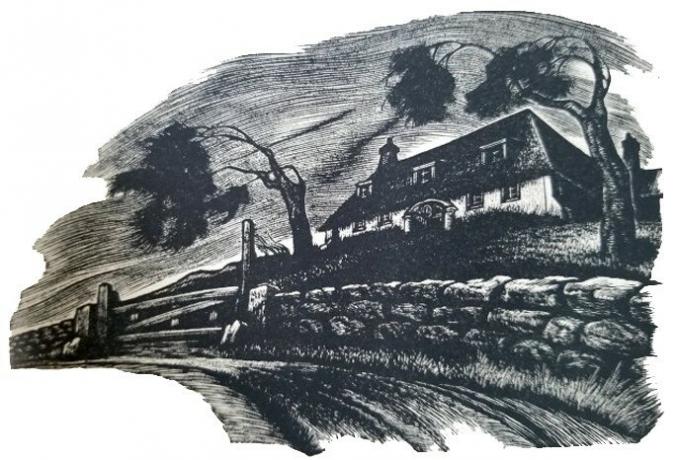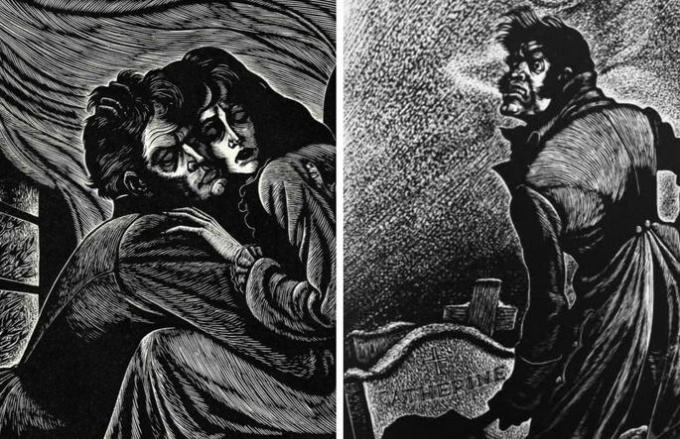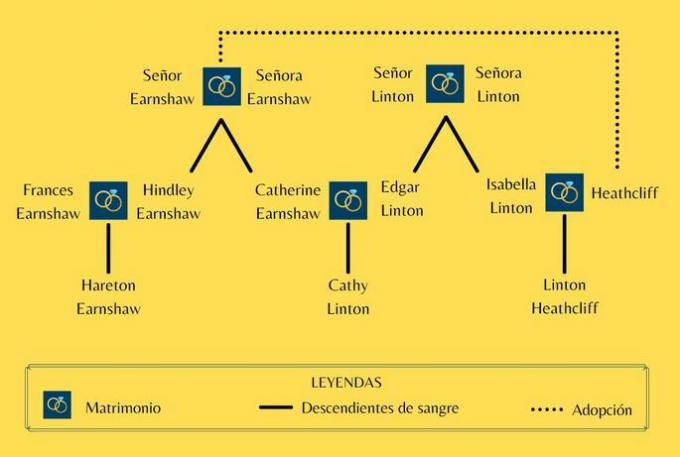Wuthering Heights book: summary, analysis and characters
Wuthering Heights is a novel by British writer Emily Brontë, published in 1847. Originally signed under the pseudonym Ellis Bell, the work stood out for its narrative structure and the obscurity of its story. While the reception was not very enthusiastic at first, it soon became a classic in Western literature.
The novel's plot revolves around passions, contempt, and revenge. Adopted by the Earnshaw family, the boy Heathcliff suffers the contempt of relatives, servants and neighbors. In addition, he suffers the rejection of Catherine, who despite reciprocating, opts for a marriage of convenience. So Heathcliff plots revenge on him. Let's see below the summary, analysis and characters of the novel.
Wuthering Heights Summary
Lockwood is the new tenant of Heathcliff's Thrush Farm. In order to finalize the details of the lease, he visits Heathcliff at his residence, called Wuthering Heights. Given the hostility with which he is received, he asks the Farm housekeeper, Nelly Dean, to explain the situation to him. Nelly Dean's tale goes back almost twenty years, when the boy Heathcliff came to Wuthering Heights for the first time.
The origin of a revenge story
The Earnshaw family lives in the Wuthering Heights house. It is made up of Mr. and Mrs. Earnshaw and their children Hindley, age 14, and Catherine, age six. His neighbors are the Lintons, who have two children named Edgar and Isabella and live on the Thrush Farm.
Mr. Earnshaw decides to adopt a gypsy boy of about 7 years, named Heathcliff. Heathcliff is rejected by Hindley. Instead, Catherine becomes his inseparable friend. Hindley is going to study abroad. She returns to the death of her father, married to Frances, to take control of the family. Shortly after, Frances dies giving birth to Hareton. Hindley indulges in vice and waste, and becomes a despot against Hareton.
The family is socially isolated and only Edgar Linton frequents them. Edgar asks Catherine to marry him. The young woman she confesses to Mrs. Dean that she really loves Heathcliff, but a union with him would lower her. So he decides in favor of Edgar. Heathcliff overhears the conversation and leaves the house without warning, determined to exact revenge on everyone.
The marriage between Edgar and Catherine
Edgar and Catherine marry and take Nelly Dean as a maid at the Thrush Farm. Heathcliff returns enriched and visits them. Later, he settles in Wuthering Heights, thanks to his interest in Hindley. Heathcliff sets out to lose him to vice and waste in order to seize his assets, as well as destroy any future prospects for Hareton.
Isabella Linton falls in love with Heathcliff, runs away with him and they marry, unaware that it is part of his revenge. This is the occasion of disagreements between Catherine and her husband. Catherine falls seriously ill while she is expecting a baby from Edgar.
The birth of Cathy and Linton
Months later, Heathcliff returns and visits Catherine, but the meeting brings out her health. Catherine dies giving birth to her daughter, who receives the same name as her, Catherine, although she is called Cathy.
Isabella discovers that Heatcliff is an evil and violent man. She manages to flee to London, where she gives birth to the only child of this union, and names him Linton. Linton won't hear from his father until twelve years later, when Isabella's death forces him to go to Wuthering Heights.
Linton, instrument of revenge
Cathy accidentally meets Wuthering Heights and makes contact with Hareton. At first he is attracted to her, but his rude manners and his ignorance make her despise him. Soon after, Linton settles down in Wuthering Heights and Cathy decides to hang out. Heathcliff sees the opportunity to marry them off to take over the Thrush Farm.
Meanwhile, Hindley dies bankrupt and Wuthering Heights passes into Heathcliff's hands. Later, Edgar Linton falls ill, and Heathcliff holds Cathy under blackmail to force the marriage. When Edgar passes away, Linton inherits his estate and passes it on to his father before dying shortly thereafter. Heathcliff orders Cathy to go live in Wuthering Heights, under the pretext of renting the house.
The love between Cathy and Hareton and the end of Heathcliff
Cathy begins to discover the noble side of Hareton, despite his rudeness and lack of education. He apologizes for the humiliations she inflicted on him in the past and begins to homeschool him. Young people fall in love. Heathcliff sees that his vengeful intent will be defeated if this union is consummated.
However, he loses interest in continuing her revenge, both fascinated and tormented by Catherine's visions and the announcement of her death. Finally, he passes away and is buried next to Catherine and Edgar Linton. Cathy Linton and Hareton Earnshaw decide to marry and occupy the Thrush Farm. Lockwood must go.
Analysis

The novel Wuthering Heights stands out for various elements. In terms of form, Brontë uses two main narrative voices, although he eventually includes others. Likewise, two narrative moments can be distinguished: the story of Heathcliff and Catherine Earnshaw, and the story of Cathy Linton and Hareton Earnshaw. Regarding the subject, the violence and the dark atmosphere of the characters brings it closer to Gothic literature, in the Victorian era.
The narrative structure
Wuthering Heights begins with the voice of a first-person narrator, in the voice of the character Lockwood. As soon as he asks her housekeeper, Nelly Dean, to tell him the story of the Wuthering Heights house, she becomes the main narrating voice. Later, Mrs. Dean's account includes other narrative voices. Like one of those Russian dolls called matrioshkas, we see one narrative within another.
This resource serves Brontë to justify the knowledge of details that neither Lockwood nor Nelly Dean could have known. This leads us to a logical conclusion: the whole story is a great testimonial text, where each character tells what he has seen in the past. The sum of all the voices allows us to build a perspective of totality on the story.
This structure developed by Brontë had already been seen before in the history of literature, but it was not frequent in a novel, but rather in compendiums of stories. For example, in the Decameron, by Boccaccio, and Arabian Nights, where a global story frames and justifies the telling of stories that are very different from each other.
The main narrating voice
The predominant narrating voice is that of Nelly Dean, who is a servant of both houses at different times in history. Nelly grew up among the Earnshaws, so she has a very close understanding of the psychology of each member of the family.
This knowledge allows her to act not only as a narrator, but also as an interpreter and sanctioner of the actions of the characters. Mrs. Dean does not repress neither her judgments nor her feeling about the behavior of the characters and the course of actions. This characteristic represents in some way the birth of the emotional voice in the narrative.
Treatment of the subject
Wuthering Heights offers a portrait of a family ruined by pride, arrogance and revenge. The atmosphere that is built is dark and charged with intense violence. All the characters suffer from it. Passions are the protagonists, but violence is the thread that ties all the evils of history.
This contrasts with what is supposed to be an environment governed by religious traditions. Although religion is concerned, spirituality has no entry into Wuthering Heights, but the mastery of emotional appetites: repressed passion and exacerbation of pride, violence, and revenge. In any case, the only spirituality that enters, through the character of José, is the one that focuses its attention on sin and recrimination.
The family is another thematic aspect addressed in the novel. We see a contrast between the Earnshaw family and the Linton family. In the former, he seems to dominate a certain tyranny from the beginning and, indeed, part of the resentment of Hindley towards Heathcliff relates to her seeing his father as a tyrant to him, but as a consenter of Heathcliff. In contrast, the Lintons appear to be a polite and affectionate family with each other.
Education also makes its appearance as a theme. When the narrator refers to the way Hareton is raised, she often calls him "like a savage." We see, then, how a tension manifests itself between civilization and barbarism, where the barbarian is in ignorance. The social structure and its customs play an important role. From them spring the prejudices of the Heathcliff characters.
Wuthering Heights and the Thrush Farm
There is an important symbolism also in the spaces where the characters develop, clearly reflected in the names of the houses: Wuthering Heights (Earnshaw home) and Thrush Farm (home of the Linton). As we can guess, in the first chaos and instability reigns, just like the winds that whipped him.
In the second, an atmosphere of peaceful tranquility is announced in which the characters seem to develop without major complications. As soon as they don't leave the Farm, the Lintons are safe. But as soon as they cross the border of Wuthering Heights, or as soon as the Earnshaws intercept them at home, the peace of their lives is frightened.
Passions in character development

In the novel we witness the gradual debasement of the characters, in a social environment in which the young people of each house feel empowered to humiliate others in the name of their education or lineage, whether they act out of habit or bad intention. This pretense of superiority resists the presence of what they consider an upstart, Heathcliff.
Sooner rather than later, Heathcliff goes from being a victim to being a perpetrator, spreading the suffering through which he passes with premeditation and treachery. He cultivates his own unhappiness, and does not realize that despite his claim to control, he will eventually lose his influence on others and fall victim to his own evil, almost an advertisement for his insanity. .
The love between this Heathcliff and Catherine acts as a catalyst for evil rather than good. The passion between them, in addition to being frustrated by the throng of social conventions and lack of opportunity, is itself destructive.
But is the love between the two the source of the conflicts in Wuthering Heights? Everything seems to indicate that no, since before Heathcliff knew of Catherine's rejection, he longed for revenge against Hindley. Thus, although there is a battle between love and hate - which is nothing more than a battle between good and evil - this is not born of the relationship between the proud lovers, but in the challenge to the social order, introduced with the adoption of Heathcliff.
From Hindley's perspective, he is an illegitimate brother who threatens his fortune. From Catherine's perspective, he threatens her social status by not being able to provide her with a last name (since he doesn't even have one). From the Lintons' perspective, he is an upstart gypsy, viewed with prejudice and fear.
Love: beginning and end of the story
Although violence dominates the story, the story of the Wuthering Heights house begins and ends with an act of love. Its beginning is in the loving adoption of Heathcliff by Mr. Earnshaw. And its end is in the relationship between Cathy Linton and Hareton Earnshaw, which thwarts Heathcliff's futile revenge efforts.
In this atmosphere, two characters of the second generation stand out: Hareton Earnshaw and Cathy Linton. From the moment he meets Cathy, Hareton, who has been raised ignorant, his feelings for Cathy make him seek his dignity.
Everything said shows that, although Wuthering Heights It is framed in a family and social conflict, the conflict between passions is what moves the threads of history.
Wuthering Heights characters

Heathcliff. Protagonist. Adopted son of the Earnshaw family. She wants revenge on the family and her neighbors, the Lintons. She is not known her last name.
Catherine Earnshaw. Younger daughter of the Earnshaws. She falls in love with Heathcliff, but marries Edgar Linton.
Hindley Earnshaw. Eldest son of the Earnshaws. Heir to the family fortune. He rejects and humiliates Heathcliff upon his arrival. Husband of Frances and father of Hareton.
Edgard Linton. Eldest son of the Lintons and young neighbor of the Earnshaws, who lives on the Thrush Farm. He falls in love with Catherine Earnshaw and they get married. Catherine “Cathy” Linton's father.
Isabella Linton. Sister of Edgard Linton. He marries Heathcliff, but flees upon discovering the mistreatment of him. She has a son by him, whom she calls Linton.
Hareton Earnshaw. Hindley's only child. Abused by his father and constantly belittled by Heathcliff, who prevents his education and deliberately bondage him. She ends up marrying Catherine Linton.
Catherine "Cathy" Linton. Daughter of Edgar Linton and Catherine Earnshaw. Cousin of Linton Earnshaw and Hareton Earnshaw. He thinks he falls in love with Linton, but in reality he loves Hareton, whom he ends up marrying.
Ellen "Nelly" Dean. He is the housekeeper of Wuthering Heights and the Thrush Farm.
Joseph. Servant of Wuthering Heights, of bitter character and deep religious devotion.
Lord Earnshaw. Father of Hindley, Catherine and Heathcliff. He was stern with Hindley and protector of Heathcliff.
Lockwood. Tenant of the Farm of the Thrush.
Other characters
- Doctor Kenneth. Treating physician for both families.
- Zillah. Maid of Wuthering Heights.
- Michael. Servant of the Farm of the Thrushes.
- Mrs. Earnshaw. Wife of Lord Earnshaw and mother of Hdinley Catherine.
- Mr and Mrs Linton. Edgar and Isabella's parents.
- Mr Green. Attorney. It was bought by Heathcliff to prevent Edgar from changing his will before he died.
- Jabes Branderham. Reverend of Gimmerden Sough.
It may interest you:
- Romantic novels
- Literary trends
Adaptations of Wuthering Heights
The novel of Wuthering Heights has led to more than one adaptation. Let's look at the most important ones.
Films
- Wuthering Heights, United States, 1939. Directed by William Wyler. Starring Laurence Olivier and Merle Oberon.
- Abysses of passion, Mexico, 1954. Directed by Luis Buñuel. Elected: Irasema Dilián, Jorge Mistral, Lilia Prado, Ernesto Alonso and Francisco Reiguera, among others.
- Wuthering Heights, UK, 1970. Directed by Robert Fuest. Music by Michel Legrand. Cast: Anna Calder-Marshall, Timothy Dalton, Judy Cornwell, Julian Glover, Hilary Dwyer, Ian Ogilvy, Harry Andrews, Pamela Brown, James Cossins, Aubrey Woods, Rosalie Crutchley, Hugh Griffith and Morag Hood.
- Hurlevent (Howling Wind), France, 1985. Directed by Jacques Rivette. Cast: Fabienne Babe, Sandra Montaigu, Olivier Cruveiller, Olivier Torres, Lucas Belvaux, Alice de Poncheville, Philippe Morier-Genoud and Marie Jaoul.
- Wuthering Heights, Japan, 1988. Directed by Yoshishige Yoshida. Cast: Yusaku Matsuda, Yûko Tanaka, Tatsuro Nadaka, Rentarô Mikuni, Eri Ishida, Nagare Hagiwara, Keiko Ito.
- Wuthering Heights, United Kingdom, 1992. Directed by Peter Kosminsky. Cast: Juliette Binoche, Ralph Fiennes, Sophie Ward, Simon Shepherd, Jeremy Northam, Jason Riddington, Simon Ward, Robert Demeger, Paul Geoffrey, John Woodvine, Jennifer Daniel.
- Wuthering Heights, UK, 2011. Directed by Andrea Arnold. Cast: James Howson, Kaya Scodelario, Nichola Burley, Oliver Milburn, Steve Evets, Amy Wren, Paul Hilton, Solomon Glave, Shannon Beer, Simone Jackson, Lee Shaw, among others.
TV miniseries
- Wuthering Heights, UK, 1978. Directed by Peter Hammond. Cast: Ken Hutchison, Brian Wilde, Pat Heywood, John Duttine, John Golightly, David Robb, Barbara Keogh, Cathryn Harrison, among others.
- Cime tempestose, Italy, 2004. Directed by Fabrizio Costa. Cast: Alessio Boni, Anita Caprioli, Franco Castellano, Luca Cianchetti, Ivo Novák and Winter Ave Zoli.



